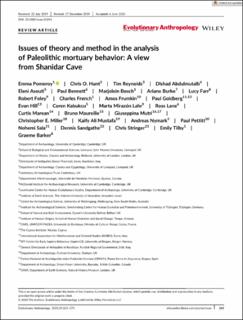| dc.contributor.author | Pomeroy, Emma | |
| dc.contributor.author | Hunt, Chris O. | |
| dc.contributor.author | Reynolds, Tim | |
| dc.contributor.author | Abdulmutalb, Dlshad | |
| dc.contributor.author | Asouti, Eleni | |
| dc.contributor.author | Bennett, Paul | |
| dc.contributor.author | Bosch, Marjolein | |
| dc.contributor.author | Burke, Ariane | |
| dc.contributor.author | Farr, Lucy | |
| dc.contributor.author | Foley, Robert | |
| dc.contributor.author | French, Charles | |
| dc.contributor.author | Frumkin, Amos | |
| dc.contributor.author | Goldberg, Paul | |
| dc.contributor.author | Hill, Evan | |
| dc.contributor.author | Kabukcu, Ceren | |
| dc.contributor.author | Lahr, Marta Mirazón | |
| dc.contributor.author | Lane, Ross | |
| dc.contributor.author | Marean, Curtis | |
| dc.contributor.author | Maureille, Bruno | |
| dc.contributor.author | Mutri, Giuseppina | |
| dc.contributor.author | Miller, Christopher | |
| dc.contributor.author | Mustafa, Kaify Ali | |
| dc.contributor.author | Nymark, Andreas | |
| dc.contributor.author | Pettitt, Paul | |
| dc.contributor.author | Sala, Nohemi | |
| dc.contributor.author | Sandgathe, Dennis | |
| dc.contributor.author | Stringer, Chris | |
| dc.contributor.author | Tilby, Emily | |
| dc.contributor.author | Barker, Graeme | |
| dc.date.accessioned | 2021-05-28T12:33:07Z | |
| dc.date.available | 2021-05-28T12:33:07Z | |
| dc.date.created | 2020-09-02T16:48:26Z | |
| dc.date.issued | 2020 | |
| dc.Published | Evolutionary Anthropology (print). 2020, 1-17. | |
| dc.identifier.issn | 1060-1538 | |
| dc.identifier.uri | https://hdl.handle.net/11250/2756903 | |
| dc.description.abstract | Mortuary behavior (activities concerning dead conspecifics) is one of many traits that were previously widely considered to have been uniquely human, but on which perspectives have changed markedly in recent years. Theoretical approaches to hominin mortuary activity and its evolution have undergone major revision, and advances in diverse archeological and paleoanthropological methods have brought new ways of identifying behaviors such as intentional burial. Despite these advances, debates concerning the nature of hominin mortuary activity, particularly among the Neanderthals, rely heavily on the rereading of old excavations as new finds are relatively rare, limiting the extent to which such debates can benefit from advances in the field. The recent discovery of in situ articulated Neanderthal remains at Shanidar Cave offers a rare opportunity to take full advantage of these methodological and theoretical developments to understand Neanderthal mortuary activity, making a review of these advances relevant and timely. | en_US |
| dc.language.iso | eng | en_US |
| dc.publisher | Wiley | en_US |
| dc.rights | Navngivelse 4.0 Internasjonal | * |
| dc.rights.uri | http://creativecommons.org/licenses/by/4.0/deed.no | * |
| dc.title | Issues of theory and method in the analysis of Paleolithic mortuary behavior: A view from Shanidar Cave | en_US |
| dc.type | Journal article | en_US |
| dc.type | Peer reviewed | en_US |
| dc.description.version | publishedVersion | en_US |
| dc.rights.holder | Copyright 2020 The Authors. | en_US |
| cristin.ispublished | true | |
| cristin.fulltext | original | |
| cristin.qualitycode | 1 | |
| dc.identifier.doi | 10.1002/evan.21854 | |
| dc.identifier.cristin | 1826879 | |
| dc.source.journal | Evolutionary Anthropology (print) | en_US |
| dc.source.pagenumber | 263-279 | en_US |
| dc.identifier.citation | Evolutionary Anthropology. 2020, 29 (5), 263-279 | en_US |
| dc.source.volume | 29 | en_US |
| dc.source.issue | 5 | en_US |

